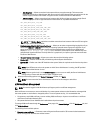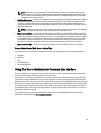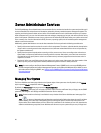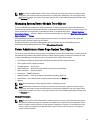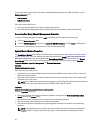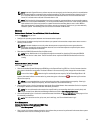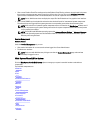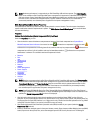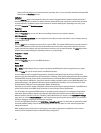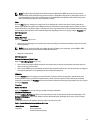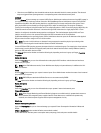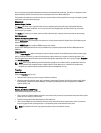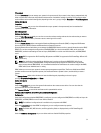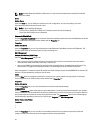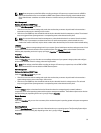
system’s LCD information can be selected from the drop-down menu. You can also enable Indication of Remote KVM
session from the Front Panel sub tab.
Batteries
Click the Batteries object to view information about your system’s installed batteries. Batteries maintain the time and
date when your system is turned off. The battery saves the system’s BIOS setup configuration, which allows the system
to reboot efficiently. The Batteries object action window can have the following tabs, depending on the user’s group
privileges: Properties and Alert Management.
Properties
Subtab: Information
Under the Properties tab, you can view the current readings and status of your system’s batteries.
Alert Management
Under the Alert Management tab, you can configure the alerts that you want to take effect in case of a battery warning
or critical/failure event.
BIOS
Click the BIOS object to manage key features of your system's BIOS. Your system’s BIOS contains programs stored on a
flash memory chipset that control communications between the microprocessor and peripheral devices, such as the
keyboard and the video adapter, and other miscellaneous functions, such as system messages. The BIOS object action
window can have the following tabs, depending on the user's group privileges:
Properties and Setup
Properties
Subtab: Information
Under the Properties tab, you can view BIOS information.
Setup
Subtab: BIOS
NOTE: The BIOS Setup tab for your system only displays the BIOS features that are supported on your system.
Under the Setup tab, you can set the state for each BIOS setup object.
You can modify the state of many BIOS setup features including but not limited to the Serial Port, Hard Disk Drive
Sequence, User Accessible USB Ports, CPU Virtualization Technology, CPU HyperThreading, AC Power Recovery Mode,
Embedded SATA Controller, System Profile, Console Redirection, and Console Redirection Failsafe Baud Rate. You can
also configure internal USB device, optical drive controller settings, automatic system recovery (ASR) Watchdog Timer,
embedded hypervisor, and additional LAN network ports on motherboard information. You can also view the Trusted
Platform Module (TPM) and Trusted Cryptographic Module (TCM) settings.
Depending on your specific system configuration, additional setup items may be displayed. However, some BIOS setup
options may be shown on the BIOS Setup screen that are not accessible in Server Administrator.
For 12G systems, the configurable BIOS features are grouped as specific categories. The categories include System
Information, Memory Settings, System Profile Settings, Unified Extensible Firmware Interface (UEFI) Boot Settings,
Network Interface Controller cards, One-Time Boot, and Slot Disablement. For example, on the System BIOS Settings
page, when you click the Memory Settings link , the features pertaining to the system memory appear. You can view or
modify the settings by navigating to the respective categories.
You can set a BIOS Setup password, on theBIOS Setup - System Security page. You must enter the password to enable
and modify the BIOS settings. Else, the BIOS settings appear in a read-only mode. You must restart the system after
setting the password.
When pending values from the previous session exist or the inband configuration is disabled from an out-of-band
interface, Server Administrator does not allow BIOS Setup configuration.
46



